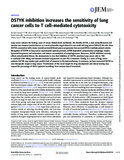Mostrar el registro sencillo del ítem
DSTYK inhibition increases the sensitivity of lung cancer cells to T cell-mediated cytotoxicity
| dc.creator | Valencia, Karmele | es_ES |
| dc.creator | Echepare, Mirari | es_ES |
| dc.creator | Teijeira, Álvaro | es_ES |
| dc.creator | Pasquier, Andrea | es_ES |
| dc.creator | Bértolo, Cristina | es_ES |
| dc.creator | Sáinz, Cristina | es_ES |
| dc.creator | Tamayo Uria, Ibon | es_ES |
| dc.creator | Picabea, Beñat | es_ES |
| dc.creator | Bosco, Graziella | es_ES |
| dc.creator | Thomas, Roman | es_ES |
| dc.creator | Agorreta Arrazubi, Jackeline | es_ES |
| dc.creator | López-Picazo, José María | es_ES |
| dc.creator | Frigola, Joan | es_ES |
| dc.creator | Amat, Ramón | es_ES |
| dc.creator | Calvo, Alfonso | es_ES |
| dc.creator | Felip, Enriqueta | es_ES |
| dc.creator | Melero, Ignacio | es_ES |
| dc.creator | Montuenga, Luis M. | es_ES |
| dc.date.accessioned | 2023-05-10T07:06:29Z | |
| dc.date.available | 2023-05-10T07:06:29Z | |
| dc.date.issued | 2022 | |
| dc.identifier.citation | Valencia, K., Echepare, M., Teijeira, Á., Pasquier, A., Bértolo, C., Sainz, C., Tamayo, I., Picabea, B., Bosco, G., Thomas, R., Agorreta, J., López-Picazo, J. M., Frigola, J., Amat, R., Calvo, A., Felip, E., Melero, I., & Montuenga, L. M. (2022). DSTYK inhibition increases the sensitivity of lung cancer cells to T cell–mediated cytotoxicity. Journal of Experimental Medicine, 219(12), e20220726. https://doi.org/10.1084/jem.20220726 | en |
| dc.identifier.issn | 0022-1007 | |
| dc.identifier.uri | https://hdl.handle.net/2454/45276 | |
| dc.description.abstract | Lung cancer remains the leading cause of cancer-related death worldwide. We identify DSTYK, a dual serine/threonine and tyrosine non-receptor protein kinase, as a novel actionable target altered in non-small cell lung cancer (NSCLC). We also show DSTYK's association with a lower overall survival (OS) and poorer progression-free survival (PFS) in multiple patient cohorts. Abrogation of DSTYK in lung cancer experimental systems prevents mTOR-dependent cytoprotective autophagy, impairs lysosomal biogenesis and maturation, and induces accumulation of autophagosomes. Moreover, DSTYK inhibition severely affects mitochondrial fitness. We demonstrate in vivo that inhibition of DSTYK sensitizes lung cancer cells to TNF-α–mediated CD8+-killing and immune-resistant lung tumors to anti–PD-1 treatment. Finally, in a series of lung cancer patients, DSTYK copy number gain predicts lack of response to the immunotherapy. In summary, we have uncovered DSTYK as new therapeutic target in lung cancer. Prioritization of this novel target for drug development and clinical testing may expand the percentage of NSCLC patients benefiting from immune-based treatments. | en |
| dc.description.sponsorship | This work was supported by Fundación para la investigación medica aplicada (FIMA), Centro de Investigación Biomédica en Red de Cáncer (CIBERONC; CB16/12/00443), Spanish Association Against Cancer Scientific Foundation (AECC; GCB14-2170), Fundación Ramón Areces, Instituto de Salud Carlos III, and cofunded by the European Union (European Regional Development Fund, “A way to make Europe”; PI19/00098; PI19/00230; PI20/ 00419), Fundación Roberto Arnal Planelles, and International Association for the Study of Lung Cancer (IASLC) Fellowship funding (K. Valencia). M. Echepare was supported by Contratos Predoctorales de Formación en Investigación en Salud (PFIS), Instituto de Salud Carlos III, and co-funded by the European Union (European Social Fund, "Investing in your future"; FI20/00295). | en |
| dc.format.mimetype | application/pdf | en |
| dc.language.iso | eng | en |
| dc.publisher | Rockefeller University Press | en |
| dc.relation.ispartof | Journal of Experimental Medicine, 219(12) | en |
| dc.rights | © 2022 Valencia et al. This article is distributed under the terms of an Attribution–Noncommercial–Share Alike–No Mirror Sites license for the first six months after the publication date (see http://www.rupress.org/terms/). After six months it is available under a Creative Commons License (Attribution–Noncommercial–Share Alike 4.0 International license, as described at). | en |
| dc.rights.uri | http://creativecommons.org/licenses/by-nc-sa/4.0/ | |
| dc.subject | Lung cancer | en |
| dc.subject | DSTYK | en |
| dc.subject | NSCLC | en |
| dc.title | DSTYK inhibition increases the sensitivity of lung cancer cells to T cell-mediated cytotoxicity | en |
| dc.type | Artículo / Artikulua | es |
| dc.type | info:eu-repo/semantics/article | en |
| dc.date.updated | 2023-05-10T06:40:53Z | |
| dc.contributor.department | Ciencias de la Salud | es_ES |
| dc.contributor.department | Osasun Zientziak | eu |
| dc.rights.accessRights | Acceso abierto / Sarbide irekia | es |
| dc.rights.accessRights | info:eu-repo/semantics/openAccess | en |
| dc.identifier.doi | 10.1084/jem.20220726 | |
| dc.relation.projectID | info:eu-repo/grantAgreement/ISCIII/Plan Estatal de Investigación Científica y Técnica y de Innovación 2017-2020 (ISCIII)/PI19%2F00098/ES | en |
| dc.relation.projectID | info:eu-repo/grantAgreement/ISCIII/Plan Estatal de Investigación Científica y Técnica y de Innovación 2017-2020 (ISCIII)/PI19%2F00230/ES/ | en |
| dc.relation.projectID | info:eu-repo/grantAgreement/ISCIII/Plan Estatal de Investigación Científica y Técnica y de Innovación 2017-2020 (ISCIII)/PI20%2F00419/ES/ | en |
| dc.relation.publisherversion | https://doi.org/10.1084/jem.20220726 | |
| dc.type.version | Versión publicada / Argitaratu den bertsioa | es |
| dc.type.version | info:eu-repo/semantics/publishedVersion | en |
Ficheros en el ítem
Este ítem aparece en la(s) siguiente(s) colección(ones)
La licencia del ítem se describe como © 2022 Valencia et al. This article is distributed under the terms of an Attribution–Noncommercial–Share Alike–No Mirror Sites license for the first six months after the publication date (see http://www.rupress.org/terms/). After six months it is available under a Creative Commons License (Attribution–Noncommercial–Share Alike 4.0 International license, as described at).



